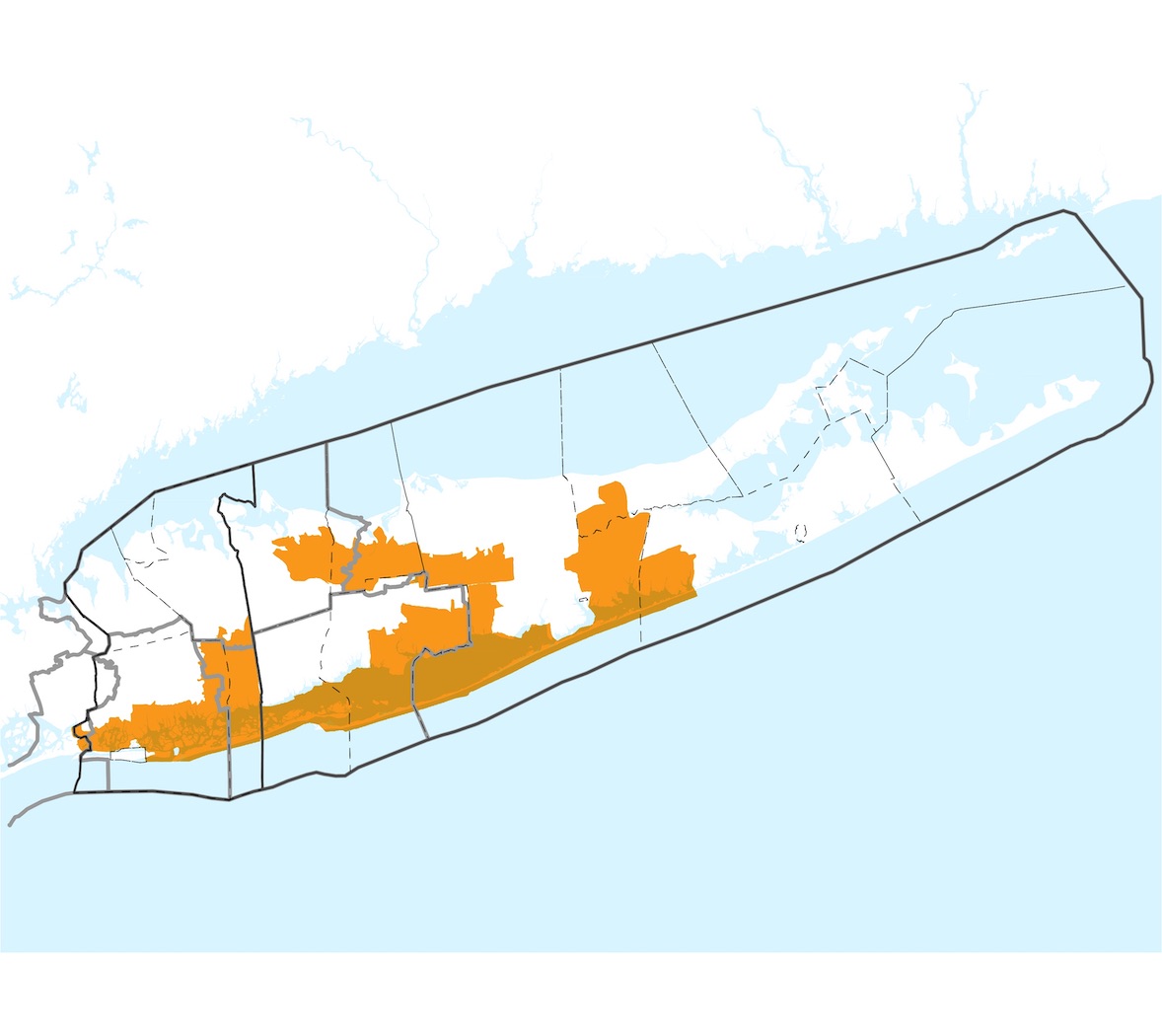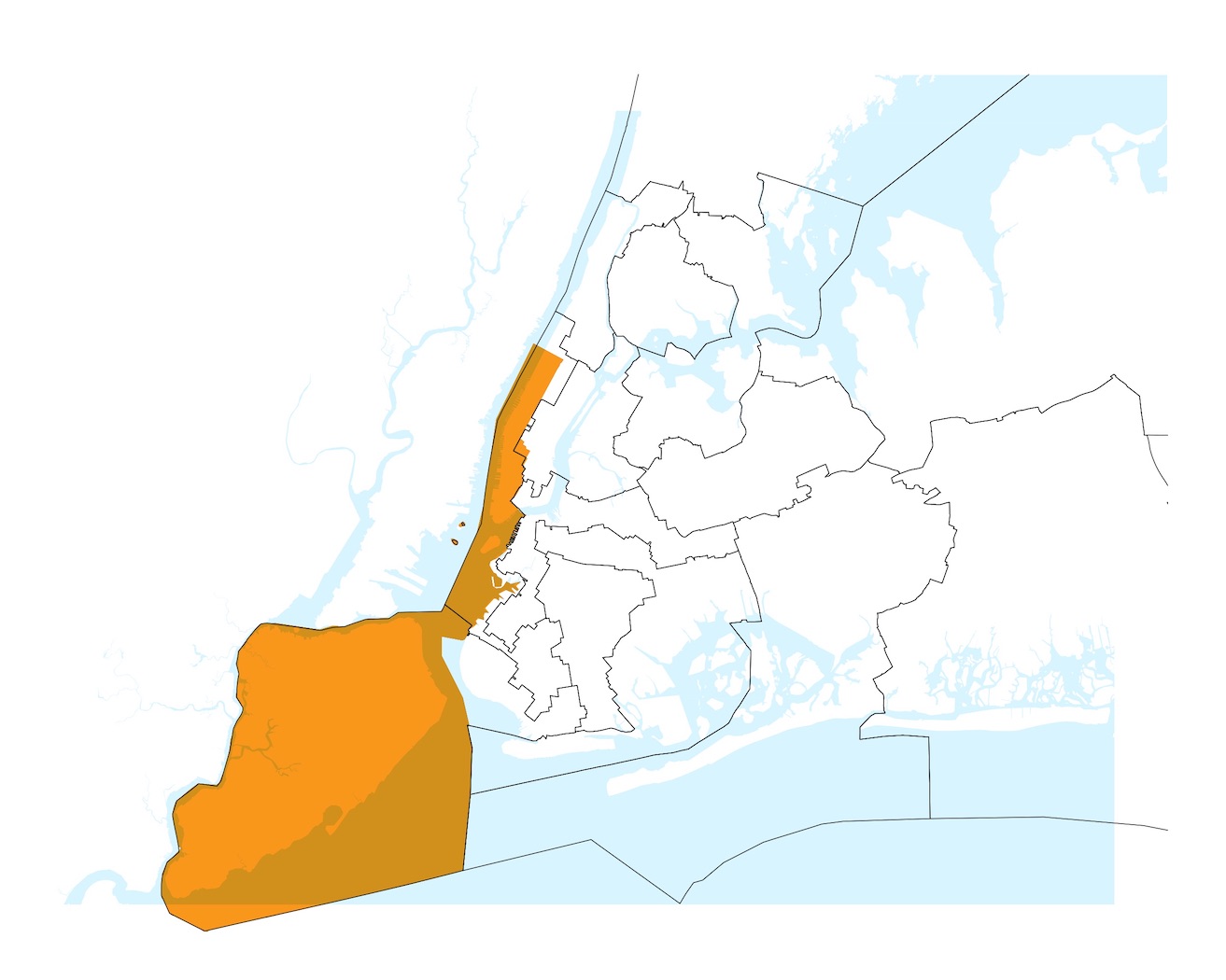Congressional and legislative district boundaries in New York have been contorted into many silly shapes over the years. One state Senate district once embodied “Abe Lincoln riding a vacuum” from the Capital Region towards Syracuse, with a stovepipe hat jutting into the Adirondacks. The “earmuff” atop Western New York was represented by longtime Democratic Rep. Louise Slaughter, while a slender slice of southern Brooklyn waterfront has long helped Republicans compete in New York by packaging the borough’s most conserative quarters with Staten Island.
In 2022, districts could become more physically cohesive, if the Independent Redistricting Commission draws ostensibly nonpartisan boundaries, or even more gerrymandered, if Democrats take advantage of their new legislative supermajorities to press their growing political advantage.
New York state lawmakers will determine the new district lines for the 150-seat Assembly, 63-seat state Senate and the as-yet undetermined number of seats in New York’s congressional delegation. (There are currently 27 members of the House of Representatives from New York, but the state is expected to lose either one or two seats, due to population shifts measured in the 2020 census.) Historically, this has been done mostly behind closed doors, with Democrats calling the shots in Assembly and Republicans in the state Senate. Courts have sometimes stepped in to resolve disputes over the congressional map – like in 2012, when a judicial panel drew new lines after the Democratic Assembly and GOP-controlled state Senate failed to reach a deal.
RELATED: Mapping Congressional Redistricting
This year, that process was expected to change. A state constitutional amendment approved by voters in 2014 mandates that a new 10-member Independent Redistricting Commission oversee the process this time around. The majority and minority leaders in both chambers of the state Legislature have already appointed two people each to the panel, totaling eight members. Those eight then chose the commission’s two remaining members. The commission’s task is to develop maps this spring, hold public hearings in the summer and then submit a final proposal to the state Legislature by a Jan. 15 deadline.
The voting rules for the commission allow seven members to submit a plan to the state Legislature as long as it has the backing of at least one member appointed by each legislative leader. If that many members cannot agree, then the proposal with the most votes moves forward, or two of them if there is a tie. In any case, a two-thirds majority vote in both houses to pass any redistricting plan, which the governor could still veto. If either legislative chamber rejects the commission’s proposals twice or the governor does so with a veto, legislators can amend the maps by a two-thirds vote in each chamber. That means if the Democrats can hold their entire caucus together in both chambers, they can overrule the commission and draw the lines the old-fashioned way.
The stakes are high beyond New York. Congressional redistricting in the state could determine whether Democrats’ slim majority in the U.S House of Representatives survives the 2022 midterms, especially with Republicans controlling more state governments than Democrats. Just how many of the eight GOP seats in the state delegation Democrats might flip next year hinges on how politically bold the Democrats are willing to be.
Democrats have little sympathy for Republicans 10 years after the GOP used their majority to gerrymander.
New census data expected in March will determine how many seats in Congress the state will lose, but the block-level data needed to determine districts themselves will not be available until September. That leaves little time for the commission to submit new maps by mid-January so that state lawmakers and Gov. Andrew Cuomo can approve them in time for the June primaries next year.
That timeline will accelerate by two weeks under a proposed state constitutional amendment passed by both chambers of the Legislature earlier this year. It also lowers the threshold for passing a redistricting plan to 60%, which will allow Democrats to more easily pass a plan that does not have universal support among their ranks. Opponents of the proposed amendment say that it undermines the greater goal of the commission. “The majority has injected partisan politics back into the process (by) rushing through a self-serving constitutional amendment in the middle of a pandemic,” state Senate Minority Leader Robert Ortt, a Republican from Western New York, said in a statement to City & State. “These changes put politicians back in charge of drawing their own districts, undermining the clear will of the voters.”
However, the voters will have a chance to make their will known: The amendment has to be ratified in elections this November.
Democrats, who now control two-thirds of the seats in both legislative chambers, have little sympathy for Republican claims of victimhood, 10 years after the GOP used their state Senate majority to gerrymander the chamber to their advantage. They argue that the amendment is necessary to get new maps ready in time for the June primaries. Whether it passes or not, Democratic partisans say tough electoral times are ahead for Republicans. “They’re setting it up as much as they can to make a significant effort to screw (the Republicans),” one Democratic insider said.

Despite Democrats’ more than 2-to-1 registration advantage, Republicans clung to control of the state Senate for most of the past half-century by engineering districts with zigzagging lines that protected their electoral chances in places like New York City, Rochester and Syracuse. “They pulled out every trick in the toolbox,” state Senate Deputy Majority Leader Michael Gianaris, a Democrat from Queens, said in an interview. Eventually, the state’s leftward shift overpowered even the GOP’s extreme gerrymander in the upper chamber. Democrats now control two-thirds of the seats in the Assembly and the state Senate. Under the current system, Republicans do not have absolute veto power over the plans developed by the Independent Redistricting Commission, but they named four of its members, as did their Democratic counterparts. Commissioners appointed last year include political luminaries like John Flateau, a business professor at Medgar Evers College, who was appointed by Westchester Democrat and state Senate Majority Leader Andrea Stewart-Cousins. Eugene Benger, a former assistant state attorney general, was named to the commission by Assembly Speaker Carl Heastie, a Democrat from the Bronx. Republican picks include former Assembly Minority Leader Charles Nesbitt of Western New York and former state Sen. Jack Martins of Nassau County.
Experts say the commission needs approximately $3 million in funding to do their work over the coming year, but commissioners have yet to even get their hands on the $1 million already allocated in the budget. The Cuomo administration said fiscal rules mean the money can only reach the commission through a registered nonprofit. Commissioners say that approach undermines their independence and results in excessive administrative costs. It could be weeks if not months before the impasse gets resolved. “We are stymied by our own elected officials, our own state officials, in trying to do our job," Martins said at a February meeting. “It’s a disgrace; it’s an embarrassment.”
They want state lawmakers and the governor to instead approve direct funding to the commission. Representatives for both Stewart-Cousins and Heastie did not respond to requests for comment by publication time about whether additional funding will be included in theirchambers' respective budget proposals expected later in the month. “We would be happy to go along with whatever solution the Legislature can work out," a spokesperson for the Department of Budget recently told the Times Union. While neither of the legislative leaders have publicly ruled out allocating additional funding in the state budget due April 1, that still leaves the commission little time to develop new maps. A spokesperson for the governor did not respond to a request for comment about his openness to getting more funding approved, though there appears to be significant support among lawmakers. “I can’t speak for the whole body, but I would advocate for it,” said Gianaris, who serves as the No. 2 Democrat in the state Senate.
“We are stymied by our own elected officials, our own state officials, in trying to do our job. It’s a disgrace. It’s an embarrassment.” – Independent Redistricting Commission member and former state Sen. Jack Martins
With Democratic control of both chambers of the Legislature assured simply by virtue of the state electorate’s preferences, the biggest question on political observers' minds is how congressional boundaries will be drawn. If and when the issue of funding gets resolved, the commissioners have to figure out how to draw new congressional districts that follow seven guidelines under the constitutional amendment approved in 2014. “It's definitely complicated,” said Steven Romalewski of the CUNY Graduate Center, who heads the CUNY Mapping Service that researches political redistricting. “It’s not just one district; it’s a jigsaw puzzle that involves all the districts.” Commissioners have to try to keep villages, towns, counties and cities within the same districts wherever possible while also making sure that they are not diminishing the electoral power of racial and linguistic minorities protected under federal law. And they have to do all of that without favoring one party over the other.
Other states like Wisconsin, Michigan and Virginia have adopted nominally less partisan ways to redraw their lines, to much praise by good-government advocates, who say New York’s commission deserves a chance to do the same. “The members of the commission appear to be absolutely determined to draw the lines in as objective and fair a process as possible,” election attorney Jerry Goldfeder, who has represented Democrats like former President Barack Obama and then-state Attorney General Andrew Cuomo, said in an interview.

Republicans are expected to do some aggressive gerrymandering in states they control as part of their efforts to flip control of the House of Representatives. The New York Times recently reported that Republicans are making moves to cut Democrats out of districts they currently control in places like Atlanta, Houston and northeastern Ohio. “The national vote could be the same as this year two years from now, and redistricting by itself would easily be enough to alter who controls the chamber,” Samuel Wang, the director of the Princeton Gerrymandering Project, told the Times. In that context, one might expect New York Democrats to bolster their party’s national prospects rather than possibly giving away seats to the opposition party through an independent redistricting process.
Democratic lawmakers have the final say on the legislative maps proposed by the commission, and their ability to pass plans of their own making will only increase if voters ratify the constitutional amendment in November. The 2014 amendment passed by a comfortable margin, and the latest proposal could benefit this year from being placed alongside popular proposals like the “right to clean air and water” and no-excuse absentee voting. Democratic turnout will also likely be high because of the New York City mayor’s race. But even if the amendment does not pass, Democrats will have the votes they need in the Legislature to effectively do what they want in the end.
“I think the Democrats should screw over the Republicans.” – anonymous Democratic operative
So does that mean Democrats will then use that power to reject nonpartisan maps and draw their own? Party insiders say the outcome may fall somewhere between the GOP’s notoriously partisan gerrymanders in states such as North Carolina, and a map that takes no advantage of their legislative majorities at all. “We're certainly not looking to help (Republicans),” state Democratic Party Chair Jay Jacobs said in an interview. “It certainly would be my expectation that we wouldn’t look to mirror them in taking extreme advantage of the situation.” But some Democrats are urging just that behind closed doors. “I think the Democrats should screw over the Republicans,” one Democratic operative told City & State.
Such a scenario could turn out to be a nightmare for incumbent Republicans. For example, rather than arranging Long Island’s congressional districts from east to west, with the electorate leaning further rightward as one gets farther from New York City, districts could be drawn horizontally, with Reps. Lee Zeldin and Andrew Garbarino duking it out in a single district that could hypothetically stretch from Queens to Suffolk County. The reelection of freshman Rep. Nicole Malliotakis of Staten Island could hinge on her ability to sell MAGA politics on the streets of Manhattan, if the city’s most Republican borough is paired with its most Democratic.
Five of the state’s eight Republicans are upstate, but upstate’s relative population loss means there’s going to be fewer seats for them. Any number of changes could doom Reps. John Katko and Claudia Tenney of Central New York as well as Chris Jacobs and Tom Reed to the west. Democratic areas of Buffalo, Rochester or Syracuse could get added to their districts, or some of them could end up having to run against each other in a future district where Democrats would pack as many GOP voters as possible. Rep. Elise Stefanik might have to start stumping for votes in blue areas of the Capitol Region that are currently outside the boundaries of her North Country district.
Democrats say they would not even have to necessarily use a heavy hand over redistricting to make the GOP suffer electorally, given the changing demographics of the state. “The numbers in New York aren’t on their side,” said Kyle Ishmael, executive director of the New York State Black, Puerto Rican, Hispanic and Asian Legislative Caucus. “So I don’t even see it as having to stick it to them – just make these districts make sense.” That could mean restoring a past congressional arrangement that joined Staten Island with lower Manhattan rather than southern Brooklyn. Or it could mean the end of a little protrusion in the district lines upstate that places Democratic-leaning Saratoga Springs in the Capital Region district of Paul Tonko rather than the North Country district represented by Stefanik. Democrats have dreamed of turning that district blue in recent election cycles, especially since Stefanik became one of former President Donald Trump’s leading defenders. Upstate population loss and Democrats’ growing registration advantage are other factors limiting Republicans’ future chances at the ballot box.
The biggest barrier to Democrats doing whatever they can to stick it to the Republicans might actually come down to Democrats themselves. Incumbents have priorities besides helping their party gain seats. At its most basic, the tension is between maximizing seats and protecting incumbents. The way to get the most Democratic seats is to lump Republican voters into as few districts as possible, while spreading Democrats into districts that lean Democratic by smaller margins. But to increase the number of those seats will inevitably mean creating more seats that aren’t quite as safely Democratic.
And then there are more individual concerns. One member of Congress years ago demanded that his district boundary move one block north to include the site of a future federal facility, according to Jeff Wice, an adjunct professor at New York Law School and former counsel to the state Legislature, who has participated in every redistricting cycle since 1980. Others have simply wanted to make sure that their residences remained in their districts. While that is not an eligibility problem for members of Congress, who only need to be state residents, getting drawn out of one’s district can leave one open to a primary challenge from someone who claims to better represent the community by virtue of living in it. Current House members like Rep. Carolyn Maloney might want to consolidate their current tri-borough districts into something simpler that boosts their reelection chances.
There are also important constituencies within the Democratic Party that cannot be disempowered. Federal law requires that redistricting not undermine the ability of racial and linguistic minorities to elect some of their own representatives. The theoretical way to craft an all-Democratic state congressional delegation, which would be to draw districts that each replicate in miniature the state’s overall demographics, could therefore violate the Voting Rights Act by creating all majority-white districts. “Black, Latino and Asian groups come together and draw maps to make sure that our communities aren't cut up,” said L. Joy Williams, president of the Brooklyn NAACP. Such considerations could limit Democrats' ability to leverage urban areas across the state to their fullest electoral advantage, though a recent decision by the U.S. Supreme Court has made political gerrymandering otherwise OK under federal law.
Republicans could still pursue legal actions against any maps approved by New York Democrats, which adds to the list of unknowns. Voters could defy expectations by rejecting the proposed constitutional amendment on the November ballot – and Democratic lawmakers will have to consider how hard to lean on their powerful supermajorities to get what they want early next year. “These decisions are not going to be made until the very end,” Wice said. “Those who think they know what's going to happen are usually the farthest removed and least knowledgeable about redistricting decisions.”
NEXT STORY: The other shoe drops for Cuomo


